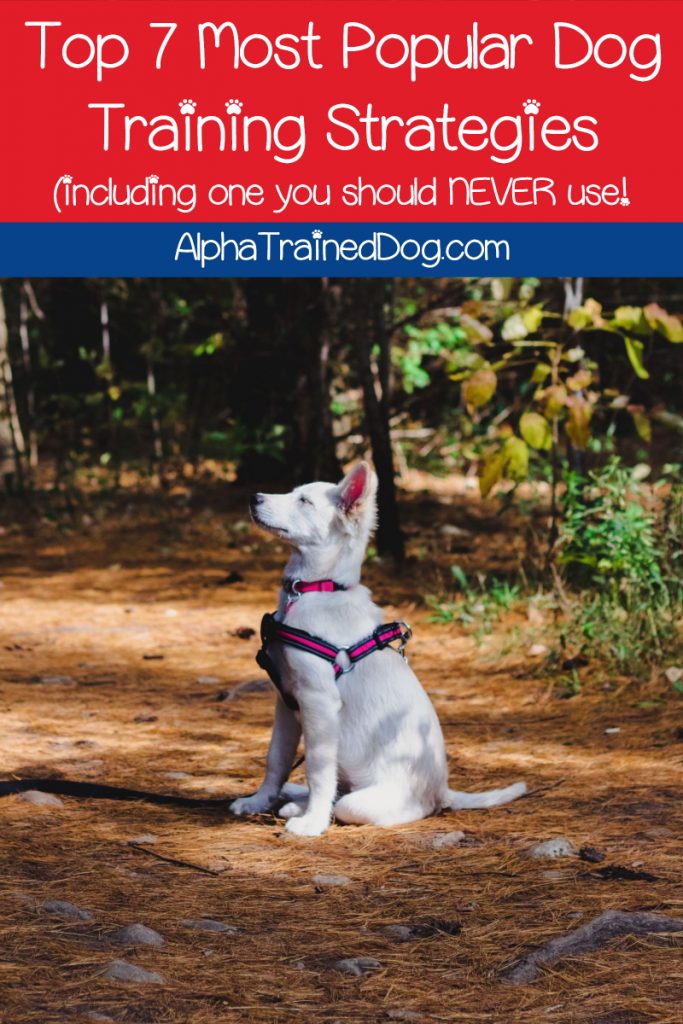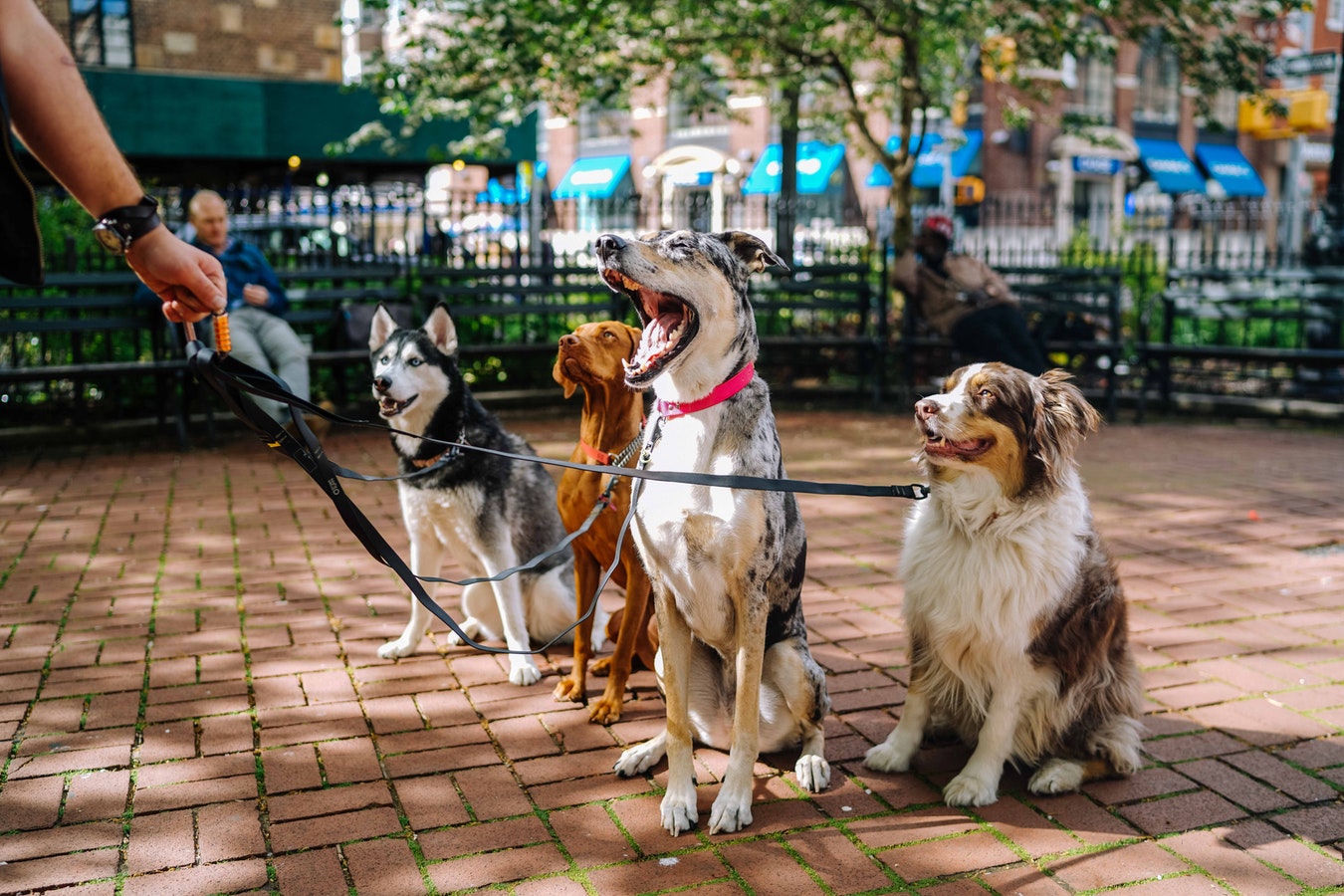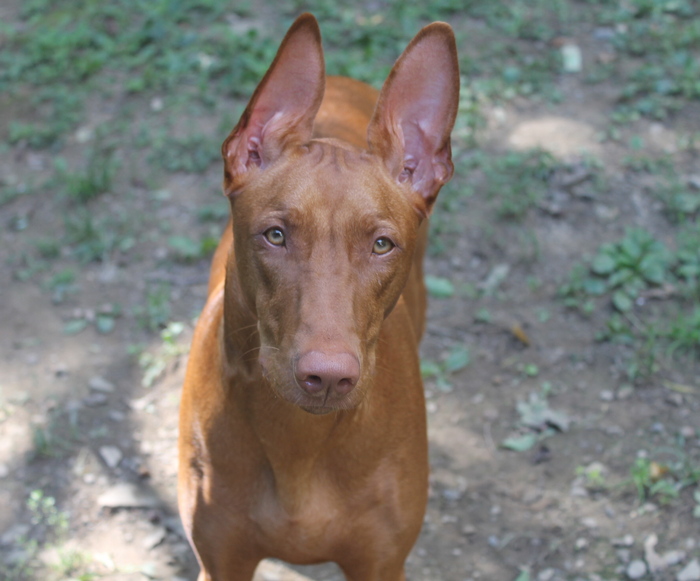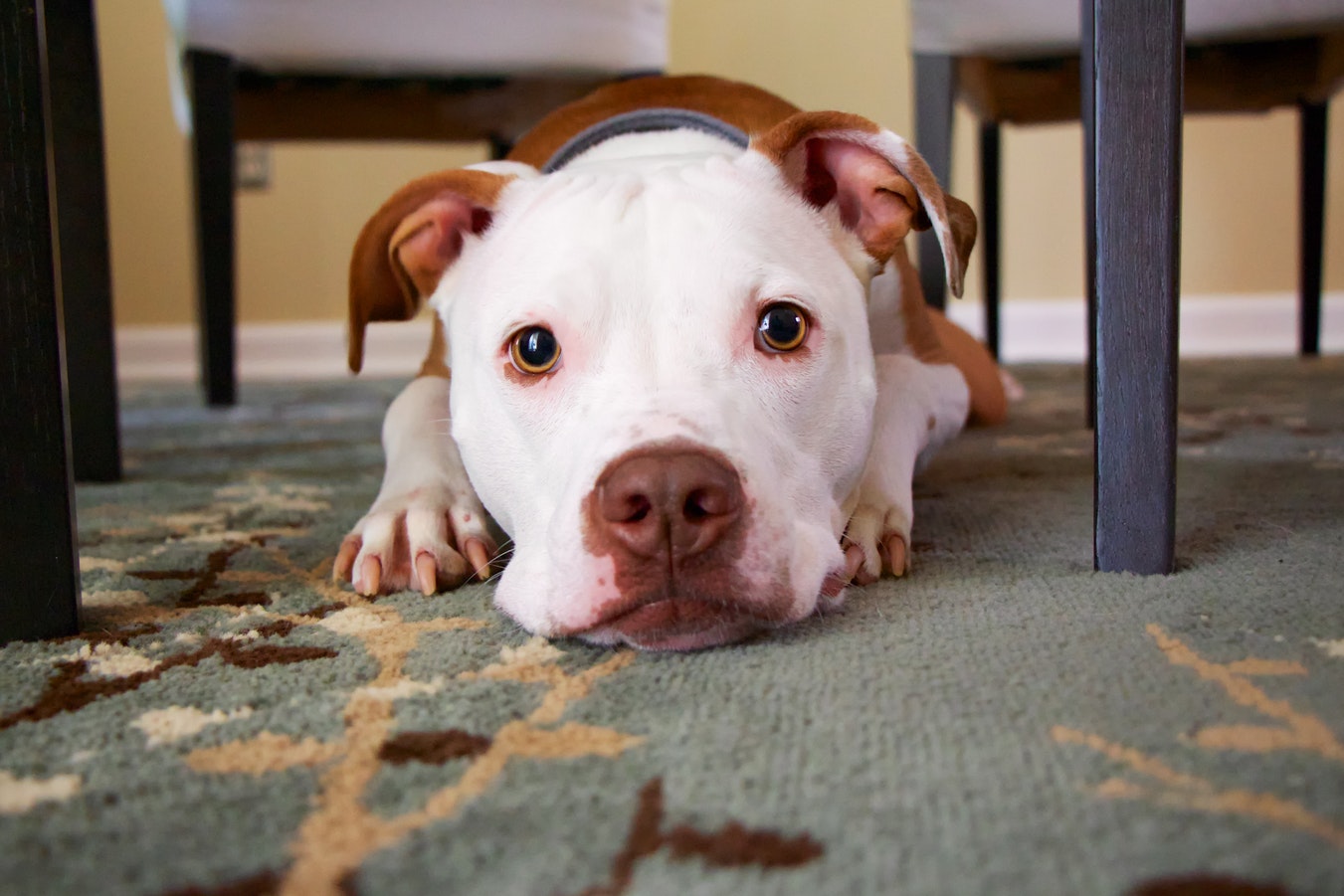Did you know that there are many different types of dog training strategies?
From alpha training a la Cesar style to classical conditioning that invokes visions of Pavlov’s bell, there’s a method for just about every type of dog and trainer.
Today, we’ll review some of the most popular ways to train a dog so you can find just the right strategy for your canine companion.
We’ll even discuss one of the least popular methods that, quite honestly, you should only use as an absolute last resort (and even then it’s questionable).
Let’s get started, shall we!

Table of Contents
Most Popular Types of Dog Training Strategies
While the three most popular types of dog training including alpha training, positive reinforcement, and conditioning training, they’re not the only games in the park!
Let’s take a closer look at those three, then delve into a few other strategies that may work for your dog (and one that rarely ever works).
Consider this a sort of “dog training methods reviews” guide, if you will!
1. Alpha Dog Training Methods
Also called dominance training, this method was made popular by Cesar Milan and his Dog Whisperer show.
The method is based on the concept that dogs, as wolf descendants, are pack animals and you need to be their “alpha leader.”

What is it?
As PostiveDogTraining explains, it’s all about teaching your dog his place in the pack and helping him understand that humans rank higher in the household.
Much of dominance training is actually about teaching YOU how to act around your dog, and how to control your own body language.
Dogs can sense fear (science has finally proven it), so when you’re emitting “scared vibes,” they pick up on it and get freaked out themselves.
Pack theory suggests that many behavior issues stem from your dog feeling like you’re not a strong leader. After all, in the world of wolves, a weak alpha can get the whole pack killed.
What’s good about it?
Alpha training seems to work well for problem cases, like aggressive dogs or those that were rescued from fighting rings.
Remember Michael Vick’s fighting dogs? Dominance training saved them from destruction and many of them went on to live happy lives in a loving “forever home.”
It’s also good for dogs that fight for dominance over each other. Since there’s already a pack leader, they’re less likely to fight for the top position.
What’s bad about it?
For a long time, it was considered the be all end all of dog training strategies, however it’s come under quite a bit of fire lately.
Recent studies show that dominance training as we know it can actually cause more harm than good to your dog when done incorrectly.
There is a difference between being a good leader to your pack and exerting dominance over your dog in a destructive way.
Where to learn more about this method
Since our site is called Alpha Trained Dog, we will focus on this training method quite a bit, obviously.
However, our goal is to help you take what’s good about it and learn to combine it with other methods for a complete strategy. Even Cesar will tell you how important that is!
If you want to learn more about alpha dog training methods, I recommend Cesar’s book “The Natural, Everyday Guide to Understanding and Correcting Dog Problems.”
- Amazon Kindle Edition
- Millan, Cesar (Author)
- English (Publication Language)
- 234 Pages - 08/08/2006 (Publication Date) - Crown Archetype (Publisher)
2. Reward-based dog training Technique
Also called positive reinforcement training, this method is exactly what it sounds like: rewarding positive (or wanted) behaviors with a tasty treat, praise, or something else your dog loves.
It happens to be my favorite training method, and the ONLY method that really works on my dog’s breed (Pharaoh Hound).

Let’s discuss that in a bit more detail, shall we?
What is it?
As I said, it’s exactly what you’d expect it to be. Basically, you give your dog a command, like sit. If she does it, she gets a reward. If she doesn’t do it, she gets nothing.
Of course, it’s a lot more involved, but that’s the gist!
The AKC takes it a few steps further by explaining that you’ll need to choose your reward to match distractions. For example,
- if you’re training at home in a low-distraction environment, you give your dog something of low value (but still not something she gets every day). For my girl Freya, that’s watermelon!
- if you’re training in a medium-distraction environment like your backyard, go with something a little more valuable, like a favorite training treat.
- when you’re out and about at the dog park, store, or other public place, use something super valuable, like a piece of cheese or meat.
What’s good about it?
Since your dog knows he’ll get a tasty reward for doing what you ask, he’s more likely to repeat the action again in the future.
It’s especially beneficial for independent breeds (like sighthounds and hunting dogs) who aren’t motivated by praise and couldn’t care less about pleasing their “pack leader.”
My dog is a “what’s in it for me?” breed. Like I said, it’s the only method that works well with her.
What’s bad about it?
It’s hard to think of something negative to say about such a positive training method, but it does have its drawbacks.
Some dogs just aren’t food motivated. Surprising, I know, but it’s true. I had a dog that didn’t really care about getting treats. She took them when offered, but they weren’t her motivator.
Fortunately, she responded well to praise, so I could still use reward training. You can also try using toys as a reward. Check out this video to learn how:
Another potential issue: dogs who will only “obey” once they see the treat in your hand. If you don’t have treats on you, it can be hard to get your dog to listen. That’s potentially dangerous when you’re out and about.
In these cases, it makes sense to combine reward training with another method, like alpha dog training methods or clicker training (more on that next).
Where to learn more about it?
If you want to learn more about reward training, I recommend grabbing a copy of “Training the Best Dog Ever: A 5-Week Program Using the Power of Positive Reinforcement.“
The co-author, Dawn Sylvia-Stasiewicz, actually trained Obama’s dog Bo.
- Amazon Kindle Edition
- Kay, Larry (Author)
- English (Publication Language)
- 431 Pages - 09/25/2012 (Publication Date) - Workman Publishing Company (Publisher)
3. Clicker Dog Training
Clicker dog training is often used in conjunction with reward-based training. Basically, it relies on a plastic or metal “clicker” to communicate with your dog.

What is it?
It’s easy to think of clicker training as some sort of Pavlonian training method, but it’s actually a lot more involved than just clicking, commanding, and treating.
Basically, this science-backed method helps your dog understand EXACTLY what part of their action earns them a reward.
For example, say you want to train Fido to roll over on command. If he’s across the room, first he has to come, then sit, then lie down, then roll onto his side, then complete the “roll over” command.
If you give him a treat at the end, he has no idea which action got him his reward. Is he a good boy for coming? For sitting? You get the picture,
With clicker training, you click at the precise moment that your dog does the “right” action. Along the way, he learns that he needs to do X and Y to get to Z (and the tasty morsel that Z brings).
If that still doesn’t make sense to you, check out this video for a good overview:
What’s good about it?
Clicker training is very humane since it’s a form of reward-based training. The click always indicates that your dog has done something right and is never used as a form of punishment.
It’s also beneficial for when you need to teach your dog a multiple-step command, as demonstrated above. Rather than giving a treat after each step, your dog learns that a click means a treat is on its way.
What’s bad about it?
The only major downside to clicker training is that you first have to train your dog to understand what the click means. It’s probably the only training method that needs “pre-training!”
The AKC calls it “charging your clicker.” Basically, you spend a few minutes each day clicking and immediately treating (use small treats so you don’t end up with an overweight dog).
Click, treat, click, treat, click, treat…until your dog learns that the click is a good thing.
Where to learn more about it?
If you’re ready to learn more about clicker dog training, check out just about any book by Karen Pryor. While she didn’t invent the method, she is the foremost expert on it.
Getting Started with Clicker Training is an obvious choice for a beginner!
- Amazon Kindle Edition
- Pryor, Karen (Author)
- English (Publication Language)
- 108 Pages - 03/21/2012 (Publication Date)
4. Relationship-based dog training
One of the more modern types of dog training strategies, relationship-based training focuses on using your relationship with your dog as the starting point for determining the best training methods.

What is it?
This method of dog training is hard to describe because it’s something different for everyone. Consider it a sort of genre mashup of many types of specialized dog training,
Rather than just choosing one training style, you’re constantly adapting your methods to meet you and your dog’s individual needs.
I love it because it’s based on your personal bond with your dog.
What’s good about it?
Along with being incredibly adaptable by nature, relationship-based training requires you to actually think about the “why” behind your dog’s actions.
Say you’re in your back yard working on the “come” command. Your dog does a great job three times in a row, but on the 4th time, he chooses to run off in the other direction.
Rather than getting annoyed with your dog or just ignoring his disobedience, you ask yourself why he ignored you, what was more appealing than your liver treat, and how you can help him ignore distractions.
You discover that he ignored you because his arch-nemesis the squirrel darting out in front of him and his prey drive is stronger than his desire for liver.
Then you work on training strategies to help him overcome his intense desire to hunt down Mr. Squirrel.
What’s bad about it?
For one thing, relationship-based training takes more time and patience than other dog training methods and involves more trial and error.
You’ll also need to be willing to adapt when something isn’t working, which is surprisingly difficult for some people (like those who feel that they’re always right).
Also, it’s not ideal for people who have a very weak bond with their dogs, or those who view dogs as little more than property.
Where to learn more about it?
For a great overview of relationship-based dog training, I recommend turning to Bones Would Rain from the Sky!
- Amazon Kindle Edition
- Clothier, Suzanne (Author)
- English (Publication Language)
- 332 Pages - 11/11/2009 (Publication Date) - Grand Central Publishing (Publisher)
5. Science-Based Dog Training
These modern dog training methods are a litter harder to define. Unlike alpha dog training strategies or reward-based training, “science based dog training” isn’t really a “do this, this and this” type of thing.

What is it?
At its core, science based dog training is a method that uses the latest information about dog behavior to create an evidence-based strategy for training your dog.
Does it feel like I just walked around in a circle with that definition? Let me try to be a little less vague. Like I said, it’s hard to define.
- Basically, when you use this training method, you spend a lot of time reading up on the latest dog behavioral studies.
- Then, you adapt your current strategy to fall more in line with what you’ve learned.
The shift away from the alpha theory is a good example of science based dog training in action. For a long time, we thought dogs were pack animals, just like wolves.
Then, animal behaviorists did a bunch of studies and found out that the whole “pack mentality” isn’t quite as accurate as we thought it was.
So, trainers adapted and developed new methods based on rewards and positive reinforcement. Science based training is always humane, as it takes your dog’s psychology into account.
The video below is pretty long (and honestly, a tad dry) but it gives a really good overview of this method:
What’s good about it?
Since it’s based on constantly evolving and updated theories, when you use science based dog training, you’re taking full advantage of what we know about the dog’s mind.
It’s also one of the most positive dog training techniques because we’re looking not just at how we can make our dogs do what we want, but how to train them in a way that also gives them what they need from us.
What’s bad about it?
While there’s nothing particular bad about it per se, it does require a lot more dedication than just buying a training book and following the author’s tips.
You’ll need to spend some time reading up on the latest studies AND know how to translate the new knowledge into your training strategy.
Where to learn more about it?
Since science based dog training is always evolving, it’s hard to just say “buy this book and you’ll be all set!”
That said, I do recommend Dog Smart by Linda P. Case because it gives you the tools you’ll need to make sense of current and future studies.
You’ll also want to bookmark some websites that stay updated with new studies. I use Science Daily, since you can search by topic.
- Amazon Kindle Edition
- Case, Linda P. (Author)
- English (Publication Language)
- 295 Pages - 02/09/2018 (Publication Date) - AutumnGold Publishing (Publisher)
6. Model-rival dog training Method
Remember that anti-drugs commercial from the 1980s where the kid yells, “I learned it by watching you!”? Well, that’s the main idea behind model-rival training.

What is it?
Also called mirror training, this strategy revolves around the idea that dogs learn how to do things by watching us do them.
The method was developed by a team of researchers in Hungary (which is why it’s also called the Hungarian clicker method).
Basically, you model the behavior you want from your dog while using the clicker to “mark” the desired action, then reward them when they “mirror” you.
Sounds super simple, right? In fact, it kind of sounds like a combo of clicker and reward training. Well, it is…and it isn’t.
See, as Dave Donovan of LovetoKnow explains, in order for it to work well, “the dog must be included in all aspects of the owner’s life.”
He also must be properly socialized AND given as much freedom as possible to follow his natural instincts.
Still not sure what it is? Check out this video to learn more:
What’s good about it?
It’s a science-based training method that relies 100% on positive reinforcement, so it’s very humane.
Also, if you have a great relationship with your dog, it has the potential to work very quickly.
For example, I play training games with Freya and we’re currently working on a multi-step routine that goes “sit, paw, down, stay, up, come, sit…and back around.”
I wanted to add “turn around” into the mix so I could start at one end of the room, then turn her before repeating the process. She learned “turn” in just one session by mirroring me.
What’s bad about it?
Again, there really isn’t anything “bad” about it, but it only works if you have a strong bond with your dog.
While that’s not a problem for most dedicated dog owners, it does mean that you can’t just start with mirror training the day you bring Fido home.
You’ll likely need to use something like reward training and/or clicker training for basic commands, then add mirror training into the mix once you’ve established that bond.
Where to learn more about it?
Since it’s relatively new, there aren’t a lot of books written specifically on the topic (I couldn’t find any, actually).
Instead, your best bet is to search “model rival dog training” on YouTube and check out the videos by experts. Along with the one above, I also recommend this one.
As far as books go, I do recommend getting a good one on bonding with your dog. I like How Dogs Love Us.
- Amazon Kindle Edition
- Berns, Gregory (Author)
- English (Publication Language)
- 272 Pages - 10/22/2013 (Publication Date) - Amazon Publishing (Publisher)
7. Electronic Dog Training (aka Shock Collar Training) Technique
Remember how I mentioned that there’s one “popular” training method that I DO NOT recommend at all? Well, this is it.
Electronic training is just a “nicer” way of saying “shock collar training,” and it should never be done by anyone other than a professional.
Even then, I don’t recommend it unless every dog training techniques for aggression have failed and it is the ONLY way to keep an animal from being put down.
What is it?
Electronic dog training uses either a shock collar or a citronella collar to give “negative feedback” for undesired behaviors.
For example, if your dog is an excessive barker, a citronella collar may deliver a burst of the spray in his face when he barks.
Another example: if your dog is aggressive and starts to lunge at another dog, you might use the remote to deliver a shock that stops him in his tracks.
If you want to learn more about it, check out this video:
What’s good about it?
I’m trying super hard to be unbiased here but I’m struggling to find something positive to say about such a negative training method.
The only thing I can think of is that it can be used a “fail safe” for dogs who tend to be aggressive.
For example, if you have a dog that’s prone to attacking other animals, you could use it while you’re out on a walk as an absolute “in case of emergency” fall back plan.
What’s bad about it?
Let me be very clear: this method of training is all about negative reinforcement and “punishment” for wrong actions rather than rewarding good behaviors.
Furthermore, there is no evidence that this type of fear-based training works any better than positive training methods.
It’s so controversial that some European countries are banning it entirely. In the US, it’s also illegal Boulder, Colorado.
Where to learn more about it?
I’m having a hard time finding a decent book to recommend. I thought I found one, but the description included words like “training your dog is a pain…”
Plus, this isn’t a training method that you should try on your own (or at all, really, but definitely not without a professional).
If you’re considering e-collar training for an aggressive dog, this book may help you find a more positive solution.
- Amazon Kindle Edition
- Miller, Pat (Author)
- English (Publication Language)
- 210 Pages - 10/30/2016 (Publication Date) - Dogwise Ebooks (Publisher)
Which dog training strategy is the best?
Now that you’ve read through all of the dog training methods reviews, you may find yourself wondering, “Well, which one is the best???”
That really depends on you and your dog. I prefer reward-based training, but as you saw, several methods include positive reinforcement in the overall strategy.
If you have a lot of patience and dedication, science based training or relationship training are good options because they rely on up-to-date techniques and a strong bond with your dog.
The only one that I absolutely do not recommend is electronic training. Sorry, I know that some people have success with it, but I just can’t get behind a fear-based training method.
What are your thoughts on the best dog training strategies? Share in the comments!









dog is very friendly and caring but am always scared of dog because of my pass experience
When I was a child I had a dog but now as an adult I am a cat person. I was looking on your page to see if you have any tips for training cats. Reward based training works very good in my opinion.
Wow I never knew how many different styles of training there were. Personally, I’d only heard of alpha style training. Thanks for the tips! I might consider some new methods for my dog!
i think i dig the clicker training the most but Alpha one does sound appealing lol. thanks for the tips and tricks shared.
This is a great resource for training dogs! My niece recently got two beagle pups and they are a handful! I think it is about time she starts training them. I will send her the link to your blog.
Such a great and very informative post. This can be very helpful especially for those wanted to have a dog.
Does certain training methods better for certain breeds
Very informative. I didnt know dog training was so complex.
We used the reward and science-based ways of training for our dog and they worked like a charm. Except now she thinks she gets a treat when she hears that she’s a good girl. But, with us not giving her a treat every time she hears that phrase, she should stop begging over time. Great post, thanks for sharing!
These are some really helpful tips for people with dogs. I will forward this information to my friends with dogs
I have always wondered how dogs get trained. Love the tips here.
I know Cesar Milan and his show The Dog Whisperer. I have watched it and got impressed with the way he emits that alpha energy. Dog’s are intelligent animals indeed.
I really don’t have any ideas that there are different dog training methods that we can do. We recently have a rescued dog a month ago we named him Haru and I would love to do some of these training methods for him. Thanks for sharing this info.
We could probably add a couple more, but please let’s not. As positive training goes its pretty easy to adapt it with other techniques and make it a binary type of exercise; there’s a yes, and there’s a no, you get acknowledged for the yes and not for the NO, it’s rewarding good choices. There’s also a lot o proprietary hype an mythical abilities, let’s be clear Cesar uses shock collars and has some pretty bad lawsuits from Heavily edited training mistakes. Suppressing that behavior and a dog can work for a moment and then backfire, but they don’t show that Its confusing in the information can be overwhelming and then training become A salad bar of methods I don’t really go together. Somethings are basic like putting in the effort and on the flip side it important train 5–10 min i A few session Research shown over and over to keep it brie there’s a tendency for most of us to train too long and get frustrated from burning the dog out. A stressed out Dog that lack Motivation is the Kryptonite of all training methods. It should be fu If it’s not then you should think about getting a cat.